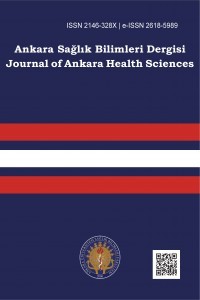FORENSİC ANTHROPOLOGİCAL APPROACH TO SKELETAL TRAUMAS IN CHILD ABUSE CASES
Child Abuse, Forensic Anthropology, Human Osteology, Skeletal Traumas, Bone Fractures, Maltreatment
___
- 1. Al-Mahroos, F., Al-Amer, E.A., Al-Hashimi, H.A., Rcsi, F., Abdulla, A.M., Hameed, N. 2011a. Abusive Head Trauma in Children: The Extent and Clinical Characteristics. Bahrain Med Bull; 33.
- 2. Al-Mahroos, F., Al-Amer, E.A., Umesh, N.J., Alekri, A.I. 2011b. Pattern of Skeletal Injuries in Physically Abused Children. Bahrain Med Bull; 33(2).
- 3. Bakwin, H. 1952. Roentgenologic changes in the bones following trauma in infants. J Newark Beth Isr Hosp; 3:17–25.
- 4. Belfer, R.A., Klein, B.L., Orr, L. 2001. Use of the skeletal survey in the evaluation of child maltreatment. American Journal of Emergency Medicine; 19(2):122–4.
- 5. Bilo, R.A.C., Robben, S.G.F., van Rijn, R.R. 2010. Forensic Aspects of Pediatric Fractures: Differentiating Accidental Trauma from Child Abuse. Springer.
- 6. Brogdon, B.G., Shwayder, T., Elifritz, J. 2012.Child Abuse and its Mimics in Skin and Bone. CRC Press.
- 7. Buchanan, M.F. 1985. The recognition of non-accidental injury in children. Practitioner; 229(1407): 815–19.
- 8. Caffey, J. 1946. Multiple fractures in the long bones of infants suffering from chronic subdural hematoma. Am J Roentgenol Radium Ther Nucl Med; 56(2):163-73.
- 9. Chauvin-Kimoff, L., Allard-Dansereau, C., Colbourne, M. 2018. The medical assessment of fractures in suspected child maltreatment: Infants and young children with skeletal injury. Paediatrics & Child Health; 23(2): 156–160. DOI: 10.1093/pch/pxx131
- 10. Conway, J.J., Collins, M., Tanz, R.R. 1993. Radkowski MA, Anandappa E, Hernandez R et al. The role of bone scintigraphy in detecting child abuse. Semin Nucl Med; 23: 321-33. DOI: 10.1016/S0001-2998(05)80111-4 11. Day, F., Clegg, S., McPhillips, M., Mok, J.A. 2006. retrospective case series of skeletal surveys in children with suspected non-accidental injury. J Clin Forensic Med; 13(2):55-9.
- 12. Holick, M., Hossein-Nezhad, A., Tabatabaei, F. 2017. Multiple fractures in infants who have Ehlers-Danlos/hypermobility syndrome and or vitamin D deficiency: A case series of 72 infants whose parents were accused of child abuse and neglect. Dermatoendocrinol; 9(1): e1279768. DOI: 10.1080/19381980.2017.1279768
- 13. Kemp, A.M., Dunstan, F., Harrison, S., Morris, S., Mann, M., Rolfe, K., Datta et al. 2008. Patterns of skeletal fractures in child abuse: systematic review. BMJ; 337:a1518. doi: 10.1136/bmj.a1518
- 14. Kleinman, P.K., Rosenberg, A.E., Tsai, A. 2015. Skeletal trauma: General considerations. In: Kleinman P, ed. Diagnostic Imaging of Child Abuse. pp. 23-52.Cambridge: Cambridge University Press. DOI: 10.1017/CBO9780511862366.010
- 15. Love, J.C., Derrick, S.M., Wiersema, J.M. 2011.Skeletal Atlas of Child Abuse (Springer’s Forensic Laboratory Science Series). Humana Press.
- 16. Love, J.C., Soto Martinez, M.E. 2017. Theoretical foundation of child abuse. In: Boyd Jr CC, Boyd DC, eds. Forensic Anthropology: Theoretical Framework and Scientific Basis. Chapter 10. John Wiley & Sons. doi: 10.1002/9781119226529.ch10
- 17. Manifold, B.M. 2012. A Probable Case of Child Abuse from Historic Gloucester. Bulletin - International Association for Paleodontology; 6(1).
- 18. Militaru, M,, Martinovici, D. 2005. Our Experience in Pediatric Sepsis. Jurnalul Pediatrului; 8: 29-30.
- 19. Ross, A.H., Juarez, C.A. 2014. A brief history of fatal child maltreatment and neglect. Forensic Sci Med Pathol;10: 413-22. DOI: 10.1007/s12024-014-9531-1 20. Ross, A.H., Juarez, C.A. 2016. Skeletal and radiological manifestations of child abuse: Implications for study in past populations. Clinical Anatomy; 29: 844-53. DOI: 10.1002/ca.22683
- 21. Silverman, F.N. 1953. The roentgen manifestations of unrecognized skeletal trauma in infants. AJR Am J Roentgenol; 69: 413–427.
- 22. Steyn, M. 2011. Case report: Forensic anthropological assessment in a suspected case of child abuse from South Africa. Forensic Sci Int; doi:10.1016/j.forsciint.2011.01.023
- 23. Swoboda, S.L., Feldman, K.W. 2013. Skeletal Trauma in Child Abuse. Pediatric Annals; 42: 236-43. DOI: 10.3928/00904481-20131022-11
- 24. Taitz, L.S. 1991. ‘’Child abuse and metabolic bone disease: are they often confused?’’. BMJ; 302: 1244.
- 25. Walker, P.L, Cook, D., Lambert, P. 1997. Skeletal Evidence for Child Abuse: A Physical Anthropological Perspective. J Forensic Sci; 42: 196-207. DOI: 10.1520/JFS14098J
- 26. White, T.D., Black, M.T., Folkens, P.A. 2012. Forensic Case Study: Child Abuse, The Skeletal Perspective. In: Human Osteology. pp. 507-512. Academic Press.
- 27. Worlock, T., Stower, M., Barbor, P. 1986. Patterns of fractures in accidental and non-accidental injury in children: A comparative study. British Medical Journal (Clinical Research Ed.)
- ISSN: 2146-328X
- Yayın Aralığı: Yılda 2 Sayı
- Başlangıç: 2012
- Yayıncı: Ankara Üniversitesi
BAZI FONKSİYONEL BESİNLERİN SAĞLIK ÜZERİNDEKİ KORUYUCU ETKİLERİ
Buse AKÇAY, Hande ÖNGÜN YILMAZ
FORENSİC ANTHROPOLOGİCAL APPROACH TO SKELETAL TRAUMAS IN CHILD ABUSE CASES
Beyhan Özge Yersel, Ender Durualp, Gülen Baran
ENGELLİ GEBELERİN KARŞILAŞTIKLARI ZORLUKLAR VE EBELİK YAKLAŞIMI
Buse Kübra KAPAN, Nur Elçin BOYACIOĞLU
Aslı ONUR, Nida TOKAÇ ER, Nurcan YABANCI AYHAN
Utku BEYAZIT, Aynur BÜTÜN AYHAN
Awareness of Sexual Health in Mothers Who Have Children with Learning Disability
Sebahat ALTUNDAĞ, Nazan ÇAKIRER ÇALBAYRAM
Şengül ÜZEN CURA, Selma ATAY, Sevda EFİL
BİR ÜNİVERSİTE HASTANESİNDE ÇALIŞAN HEMŞİRELERİN KANITA DAYALI HEMŞİRELİĞE YÖNELİK TUTUMLARI
Sevgi DENİZ DOĞAN, Seda YIKAR KARAÇAY, Sevban ARSLAN, Şeyma YURTSEVEN, Evşen NAZİK, Sevilay ERDEN YÜKSEKKAYA
